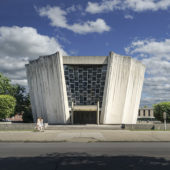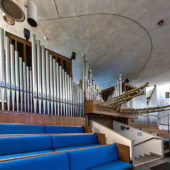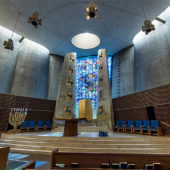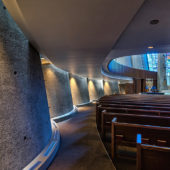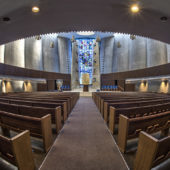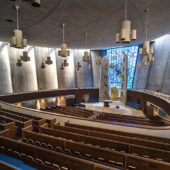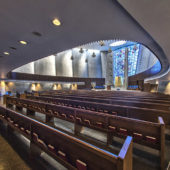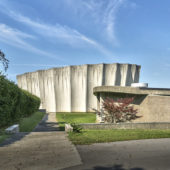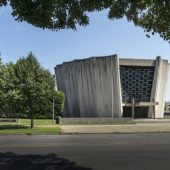One of the oldest and largest Reform congregations in the nation with a sanctuary that is a 20th Century architectural icon.
In 1825, fifteen years after the founding of Buffalo, the Jewish politician and playwright Mordechai Manuel Noah bought the huge island which languishes in the Niagara River between Buffalo and the Falls. Naming the island Ararat, he established it as a refuge for the Jewish people. This combination Jewish Nirvana and flood prone Promised Land was soon abandoned without even leaving a synagogue for to photograph. However, the City of Buffalo flourished because it was a transfer point linking the Great Lakes with the Erie Canal, thus being the freight and transportation hub connecting New York (and the world) with cities such as Detroit, Cleveland, Chicago and the vast American west beyond.
Where commerce flourishes there are Jews and Buffalo was no exception. From an 1850 meeting at the home of Buffalonian Hirsch Zinzheimer, Temple Beth Zion grew into one of the oldest and largest Reform congregations in the nation. When railroads made the Erie Canal obsolete, Buffalo had an extra advantage that helped its economy continue to grow: Niagara Falls. The rushing water was a potent source of energy, harnessed to produce electricity by means of an enormous underground tunnel to power the city and generate hydroelectric power. By 1901, Buffalo was known as “The City of Light”. It hosted the Pan American Exposition which featured dazzling electric light displays ushering in the electrical revolution. This revolution was like the computer revolution in that it fundamentally changed the way people lived and Buffalo was that era’s Silicon Valley. On the east side of Buffalo alone there were twelve Orthodox synagogues as well as a Jewish library and a community house. In the 1950s, with the opening of the St. Lawrence Seaway, Buffalo lost much of its heavy industry, and improvements in electricity transmission rendered proximity to Niagara Falls increasingly irrelevant. Over the last 50 years, the city has lost 50% of its population yet there remains a strong Jewish community with 10 synagogues of varying sizes.
Temple Beth Zion’s current building was dedicated in 1967. Located on Delaware Avenue, a broad, tree-lined boulevard defined by graceful turn-of&45;the-century stone buildings and mansions from Buffalo’s heyday, uber-modern Temple Beth Zion synagogue is an amazing visual surprise.
It took more than two years to obtain permission to photograph this remarkable architectural icon designed by architect Max Abramovitz (1909 – 2004). Like a huge bowl-shaped vessel open to the heavens, the exterior walls flare outward 15 degrees as they thrust upward towards the roof which seems to float in sunlight. The 1,000 seat sanctuary consists of 10 scalloped walls symbolizing the Ten Commandments, 60 foot ceilings and two 30 foot high commandment tablets, along with two magnificent stained glass windows which were created by artist Ben Shahn. The 4,000 pipe organ is by the Casavant Freres Company.
Max Abramovitz, son of working-class Romanian immigrants, is known for his design of the Avery Fisher Hall at New York’s Lincoln Center, his work on the Exxon, Celanese and Corning Glass buildings, United States embassies in Havana and Rio de Janeiro as well as the United Nations Complex. During World War II, he built air fields in China for General Claire Chennault’s Flying Tigers and received the Legion of Merit.
When asked about his philosophy of architecture, Abramovitz told a reporter he believed people should not have to ask why he designed a building a certain way but should simply feel that “it’s the only way it should have been done.” Indeed, Temple Beth Zion is a remarkable modern gem set in a hundred year old setting. It has a sense of permanence, importance and inevitability in accord with the architect’s philosophy.

